Chapter Thirty-Two

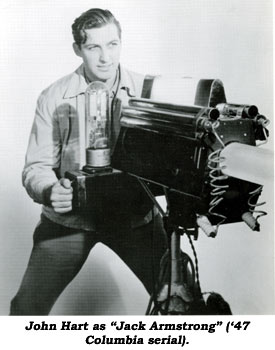
BM: What are your recollections of making “Jack Armstrong” (‘47 Columbia)? Who was your stunt double?
JH: I did damn near (all the stunts) myself. But Jack Buchanan did fall off a platform into a chasm for me (Ch. 3). He did one or two stunts for me. (Buchanan is also the Aeroglobe pilot in “Jack Armstrong” and is the deputy sheriff in “Hop Harrigan” ‘46—ed.) I did everything in that show. Jack might have done some long shots. Katzman had a lot of money in that serial, with a five week schedule where most (of his) serials were made in three weeks. There’s one funny thing…I was supposed to do a fight in one place and then I was supposed to do something else at another location. The second unit kept holding me up and the first unit started yelling for me to do this fight. So I came up with the idea, when you drive me over in the truck we’ll do the fight while you’re driving me over there. (Laughs) I think Ken Terrell was the bad guy and we did a whole big fight in the back end of this truck while it was rolling along (Ch. 13).
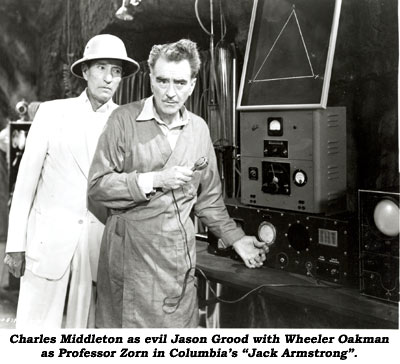 BM: Was Charles Middleton brought in late to the picture? BM: Was Charles Middleton brought in late to the picture?
JH: No. That’s a strange story. Katzman was so cheap. He wanted Charles Middleton but they hired him after they’d made the (on-screen) title credits. Katzman was so cheap he wouldn’t change the titles, so Charles Middleton got no screen credit, but he was there from the beginning.
BM:The director was Wallace Fox?
JH: Wallace Fox was older than Hell; he’d been working in movies forever. I’d get to talking to him and he’d tell me how they used to all meet at the studio and get into cars and just drive around until they’d find something (an interesting place to shoot.) Then they’d pile out of the cars...shoot what they needed...they didn't have to bother with sound.
BM: In CLIFFHANGER #18 it says, “During the filming of a scene from ‘Jack Armstrong’, five live shots were fired at John Hart from a powerful rifle. The bullets found their mark in oak trees only scant inches away from the actor who was tightly bound to a tree. They had opted to take a chance with a live bullet in order to complete the shot.” Is that true?
JH: Damn right it’s true…but it wasn’t in “Jack Armstrong”! It was up at Lake Sherwood on “Last of the Redmen” when I was doubling Jon Hall and Al Wyatt doubled Michael O’Shea. I was also swimming the lake with boots on. Usually, if you have water in a battle, they have little air things they can pull triggers on and they puff up and look like shots hitting the water. But, instead of going to all that trouble and hiring all that stuff, they (Katzman) got the idea to have a guy really shoot. I’d been in the Army so I knew rifles can fall over and get the sights banged around, but I had perfect faith in the guy that was gonna do the shooting. But—I got all ready to go and I said, “Wait a minute. Let me see you hit something.” I wanted to be sure the gun was working and he knew how to use it. There was a pine cone pretty far off down the road so I said, “Lemme see you hit that pine cone.” Bang. He hit it. So I said, “Okay.” I swam across the lake with heavy boots on, I thought I’d drown anyway, and these shots are going plunk, plunk, plunk all around me, pretty close. I could hear ‘em plunking in the water. When I got through with that, they wanted to do another one around a tree. They usually put squibs in there and blow it out. But it was cheaper for him to shoot. So I ducked behind a tree, he’d shoot, then I’d stick my head out, duck back, he’d shoot—later I thought that’s the dumbest damn thing I ever did! It was dumb enough to do the water thing, but the tree thing was worse! But, no it wasn’t in “Jack Armstrong”.

BM: What do you remember about others in the cast?
JH: Rosemary LaPlanche was a sweet, nice, lovely girl. They didn’t give her much to do in this serial. Pretty good actress. I liked her tremendously. No monkey business or anything. A nice person. She was Miss America. (in 1941. Was married to radio emcee/TV producer Harry Koplan until his death in ‘73. She became a professional artist after leaving the screen in ‘49. Rosemary died in ‘79 at 55.—ed.) Claire James was in some beauty contests as well, like a runner up. (James began in ‘40 at MGM, then was at Warner Bros. and Fox, finally Columbia. She also used the name Carol Stevens. Married briefly to choreographer Busby Berkeley, Claire died in ‘86 at 65.—ed.) Joe Brown was a pretty good actor…kind of a fat kid…not real fat but he was treading on Joe E. Brown’s name. He had no relation to Joe E. Brown. Pierre Watkin (1887-1960) was a wonderful guy. He and I became pretty good friends. He used to buy cheap race horses and run ‘em. Not too high falutin! A real nice, pleasant, good guy. On the fights and stunts if it wasn’t too difficult he did it. Eddie Parker and Jack Ingram were buddy-buddies. I would join them drinking after hours. I had a lot of fun with those guys. Eddie Parker worked for a funeral home at one time and (Laughs) every time the hearse would take a corpse to the cemetery, he’d jump in the back, ride along and try on the guy’s shoes! True or not, that’s what he said. (Laughs) The cave set was on the Columbia lot…they move those things around on wheels.
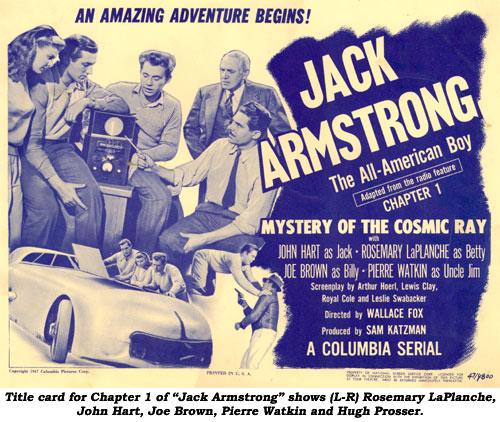

In Ch. 2 of Republic’s “Dangers of the Canadian Mounted”, following a fight in the cave, Jim Bannon (on horseback) pursues Anthony Warde who is in a car. Jim does not have on his hat. However (in stock footage used from “King of the Mounties”) he is wearing a hat as he rides. |
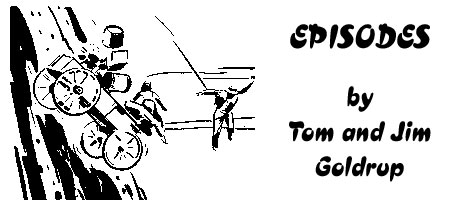
Don Harvey
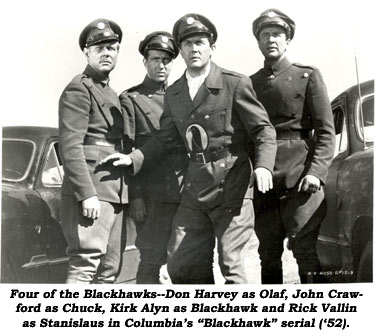 What do the serials “Blackhawk”, “Adventures of Sir Galahad”, “Gunfighters of the Northwest”, “Batman and Robin”, “Atom Man Vs Superman”, “Don Daredevil Rides Again”, “Perils of the Wilderness”, “Captain Video” and “Blazing the Overland Trail” have in common? They all featured actor Don Harvey. What do the serials “Blackhawk”, “Adventures of Sir Galahad”, “Gunfighters of the Northwest”, “Batman and Robin”, “Atom Man Vs Superman”, “Don Daredevil Rides Again”, “Perils of the Wilderness”, “Captain Video” and “Blazing the Overland Trail” have in common? They all featured actor Don Harvey.
Don Carlos Harvey was born Dec. 12, 1911, in Mar-quette, KS, and was raised in the historic Kansas town of Council Grove, the last supply stop on the old Santa Fe trail before heading west. The old Last Chance store was later converted into a residence, and this is where his divorced mother raised Don, who was known as Carlos in his younger days.
Don began acting in high school plays and also served as assistant editor of the school year book. In 1928 he was a member of the football team. After graduation in 1929, Don attended Salt College Business College in Hutchinson, KS, where he graduated in ‘32. Don returned to Council Grove where he was invited to be Master of Ceremonies at the weekly amateur night at the Stella Theater. At this time there was a traveling theater troupe called the Model Players. They had a circuit, playing five nights a week, each night in a different town, with the Friday night performance being at the Stella Theater in Council Grove. The owner of this stock company, Harry Clark, spotted Don at one of the amateur nights, was impressed with his ability, and invited him to join the troupe.
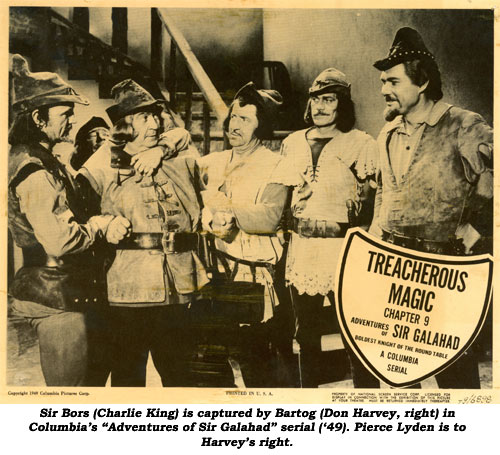
Clark’s step-daughter, Jean Bartness, was the ingenue in their plays while Don became their leading man. Falling in love, Don and Jean were married on March 5, 1934. A local resident told us, “Don and Jean did a lot of shows. They went to Harrington one night, to Osage City the next, and so on. They did the same show in all five places, they would present that show and rehearse another show for the next week. They were really talented.” Betty Strom of the Morris County Historical Society told us Don had been in Council Grove in the chataqua when she was a little girl. “They had it down here about ‘36-‘37 in Simcock’s Grove, and he played down here for one year.”
Don next moved to Sioux Falls, SD, where he was an announcer for KSCO and KELO radio stations. Frankie Prather, a boyhood friend said, “He was in South Dakota and Iowa in radio. He knew Ronald Reagan who was on the same radio station. His mother told me the public couldn’t understand his name (Carlos) so he went to his first name of Don. After that, all his credits went by Don C. Harvey.”
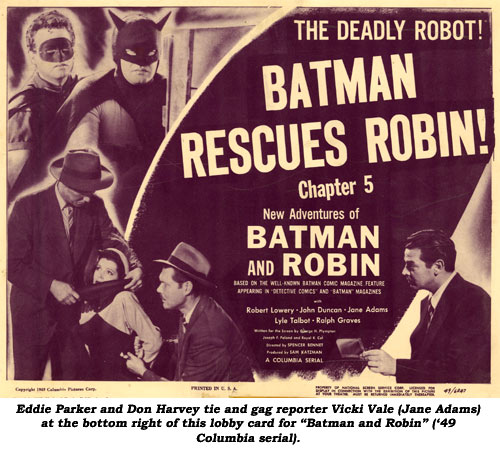
Don worked several years in radio, then he mentioned to us, “I went from there to Hollywood in ‘44. My first picture was ‘That Night with You’ with Franchot Tone at Universal in ‘45.” The bulk of Don’s film career was in westerns, and in ‘49 he appeared in his first two serials, “Adventures of Sir Galahad” and “Batman and Robin”.
Several comments made about Don by several of his serial co-stars are: Gregg Barton: “Don was a serious thespian—He walked proud.” House Peters Jr.: “He was such an easy going chap and a much finer actor than given credit for. He also gave of his time to entertain at the Actor’s home. He was one of the most giving people in the business.” Terry Frost: “I worked with both Don and Jean. They were confident actors and nice people.” Pierce Lyden: “Don was a hard and serious worker with our Hollywood Christian Group, and greatly responsible for my rededication and re-affirmation of faith in Jesus Christ as my savior.”
A childhood friend from Council Grove visited Don in California in ‘55. She told us, “We contacted Carlos (Don) and he met us at Warner Bros. and took us to lunch there in a restaurant. You don’t see people say grace out there before they eat, especially in restaurants, but we did that day. I recognized a lot of actors, and he introduced us to a lot of them. He was a perfect host.”
Don died of a heart attack at his home in Studio City, CA, April 24, 1963. Don’s wife Jean also worked as an actress in movies. “They were devoted to each other and she got to a point where she just couldn’t go on,” a friend told us. “She just died from a broken heart.”


Trapped inside a safe at the cliffhanger of Ch. 2 of “Zorro’s Black Whip”, The Black Whip (Linda Stirling) recoils in fear as a keg of explosives goes off. Instead, in Ch. 3, never cowering, she locks the powder keg between the inner and outer vault doors which are then blown open. |

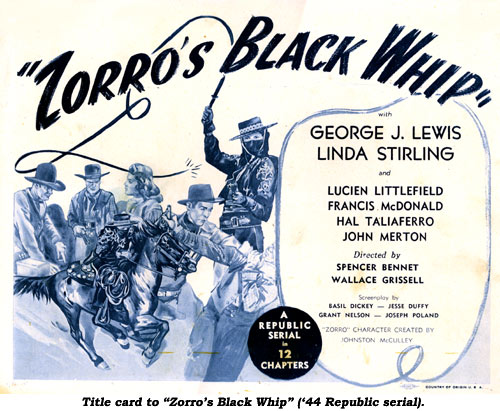
You have to wonder what Johnston McCulley thought—if he thought anything at all—about Republic’s third Zorro cliffhanger outing, ‘44’s “Zorro’s Black Whip”. Since McCulley was, at best, an entertaining pulp writer, albeit a prolific one, the creator of Old California’s masked Robin Hood was probably overjoyed to see new royalties roll in, yet it still must have been odd for him to note what strange things were happening to his original creation.
Of course, in reality, nothing was happening to his creation because, title and credit acknowledgements aside, Zorro is not present in this serial. He is not mentioned a single time. Instead, the hero is a masked character called The Whip, killed in the line of duty in the first chapter, mourned by his spunky sister Barbara who decides to carry on the family tradition (luckily not only does the same suit fit them both but, for reasons never fully explained, she is devilishly proficient with a gun, whip and horse) and wages war against those forces out to deny 1889 Idaho statehood.
 Now this serial was made long before women became commonplace as gun-toting, karate chopping heroines in the cinema. You had a few exceptions like Wonder Woman, Mary Marvel and Sheena in the comics but, for the most part, strapping on a six-shooter and tangling directly with males was new terrain for the so-called fair sex. Little boys of the period probably were not overly crazy about this role reversal though I’ll wager those fathers who escorted their offspring to Saturday matinees probably didn’t mind all that much. Now this serial was made long before women became commonplace as gun-toting, karate chopping heroines in the cinema. You had a few exceptions like Wonder Woman, Mary Marvel and Sheena in the comics but, for the most part, strapping on a six-shooter and tangling directly with males was new terrain for the so-called fair sex. Little boys of the period probably were not overly crazy about this role reversal though I’ll wager those fathers who escorted their offspring to Saturday matinees probably didn’t mind all that much.
In any case, Republic was lucky in its casting of this unique role to have serial star Linda Stirling under contract because, in all honesty, a lot of actresses probably couldn’t have carried it off (although I wouldn’t have minded seeing Adrian Booth give it a try). Linda, beautiful, tall and athletic—and helped by a lot of excellent stunt work—played it straight and heroically and pulled it off fairly well.
 Of course, suspension of belief is a big part in viewing any cliffhanger, but I must say credulity is stretched even further than usual when the cast of villains (guys like John Merton and Hal Taliaferro) are totally oblivious to the fact The Whip emerges after Chapter One with a noticeably more provocative wiggle and form, even after, in some instances, they physically tussle with her. All this aside, “Black Whip”, energetically directed by the team of Spencer Gordon Bennet and Wallace Grissell, can be quite entertaining, and not just because of Linda wielding that black whip or the myopia on the part of the bad guys. There’s a lot of good action sequences and chapter endings thanks in no small measure to Yakima Canutt’s second unit work), even if some of the footage is redundant, culled from earlier Zorro outings, and too often features the western cliffhanger staple of our heroes unconscious in wagons plunging over cliffs. Of course, suspension of belief is a big part in viewing any cliffhanger, but I must say credulity is stretched even further than usual when the cast of villains (guys like John Merton and Hal Taliaferro) are totally oblivious to the fact The Whip emerges after Chapter One with a noticeably more provocative wiggle and form, even after, in some instances, they physically tussle with her. All this aside, “Black Whip”, energetically directed by the team of Spencer Gordon Bennet and Wallace Grissell, can be quite entertaining, and not just because of Linda wielding that black whip or the myopia on the part of the bad guys. There’s a lot of good action sequences and chapter endings thanks in no small measure to Yakima Canutt’s second unit work), even if some of the footage is redundant, culled from earlier Zorro outings, and too often features the western cliffhanger staple of our heroes unconscious in wagons plunging over cliffs.
George J. Lewis, usually seen in villainous roles in serials (and later in life as Guy Williams’ father in Disney TV’s “Zorro”), provides the muscle when Linda needs it (and who gets slugged over the head in nearly every episode). The cast also includes such stalwarts as a pre-“Superman” John Hamilton, Tom London, Duke Green, Ken Terrell, Francis McDonald, and stuntmen/actors Tom Steele and Dale Van Sickel.
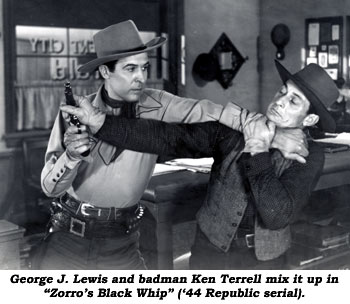 It’s not a great serial, by any means, but it’s an entertaining one and, at times, a good deal of fun, the most important ingredient of any cliffhanger. It’s not a great serial, by any means, but it’s an entertaining one and, at times, a good deal of fun, the most important ingredient of any cliffhanger.
top of page |


